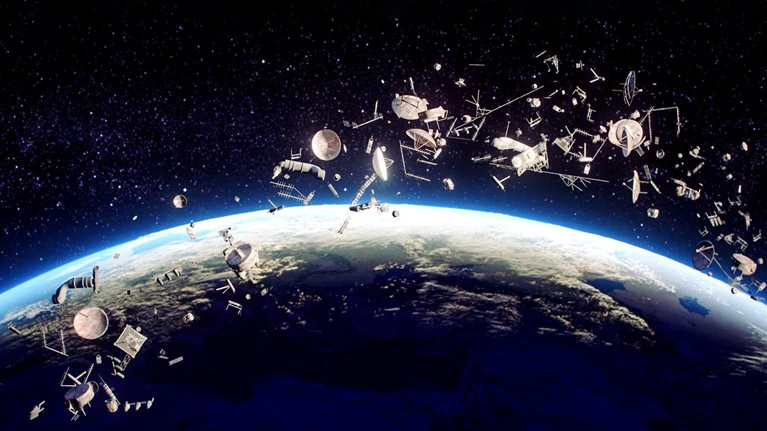Ever heard of Space Junk? Well, if not, Space Junk (or Space Debris) is a layer of many pieces of machinery or debris which have been left by humans in space. It consists of big objects such as dead satellites that have failed or been left in the orbit at the end of their mission and even smaller things, like bits of debris or paint flecks that have fallen off a rocket.
The number of pieces in this layer is continuously increasing day-by-day and is becoming a big threat to us and our future. But how? Let us understand.
This layer has many harmful effects like:-
1) It effects our environment by releasing compositional chemicals into the atmosphere which eventually lead to depletion of ozone layer.
2) Micrometeorities like paint flakes and solidified droplets of anti-breeze can cause damage to solar panels on active satellites.
3) It can disrupt future space missions from earth if the layer increases to a great extinct.
4) Some other harmful debris can include vestiges of solid fuel which float about in space and are lightly inflammable. They can cause damage and disperse pollutants into the atmosphere in case of explosion.
Did you know, in its 20 years of operation, ISIS has had to shift its way 30 times on missions to avoid being hit by space debris!
This information is enough to make us realise how harmful space junk can be in the future if it is not controlled. In light of this, organisations like NASA are trying to bring back satellites immediately after their missions are over which will prevent them to spread more junk.
But this is not enough to cope up with the amount of space junk which is there and more ways to stop space junk are required. Some of them are:-
1) Utilising genetically engineered microorganisms to degrade space debris. These microorganisms could be designed to feed on specific materials commonly found in space debris, such as metals or plastics. They would be equipped with mechanisms to break down the debris into smaller, harmless components or convert them into a gas that would naturally disperse in space. The genetically modified microorganisms could be deployed via specialized capsules or satellites strategically positioned in space. This approach would harness the natural processes of biological degradation to clean up space debris in a sustainable and environmentally friendly way.
2) Utilizing miniature, autonomous "debris-eating" robots. These robots would be designed to navigate through space, identifying and ingesting small debris particles. Once full, they could either return to a designated collection point or self-destruct, allowing the debris to burn up harmlessly in the Earth's atmosphere.
3)Employing a system of "orbital trash collectors" equipped with advanced artificial intelligence (AI) and machine learning algorithms. These collectors would autonomously navigate through orbital space, identifying and classifying various types of debris using onboard sensors and cameras. Once identified, the collectors could use robotic arms or other mechanisms to capture and secure the debris.
4) Using directed energy beams, such as microwaves or plasma beams, to selectively target and disintegrate space debris? These beams could be emitted from ground-based stations or satellite-mounted systems and precisely aimed at debris objects. Upon contact, the energy from the beams would vaporize the debris, causing it to disintegrate into smaller particles that would then naturally re-enter the Earth's atmosphere and burn up harmlessly.
There can be many other ways which we can develop to depelete space junk. All we have to do is spread awareness, search for for solutions and try to execute them to save ourselves from this layer of junk. With this, its me signing off hoping that we spread awareness about this and take space junk's problems seriously for our own good.

